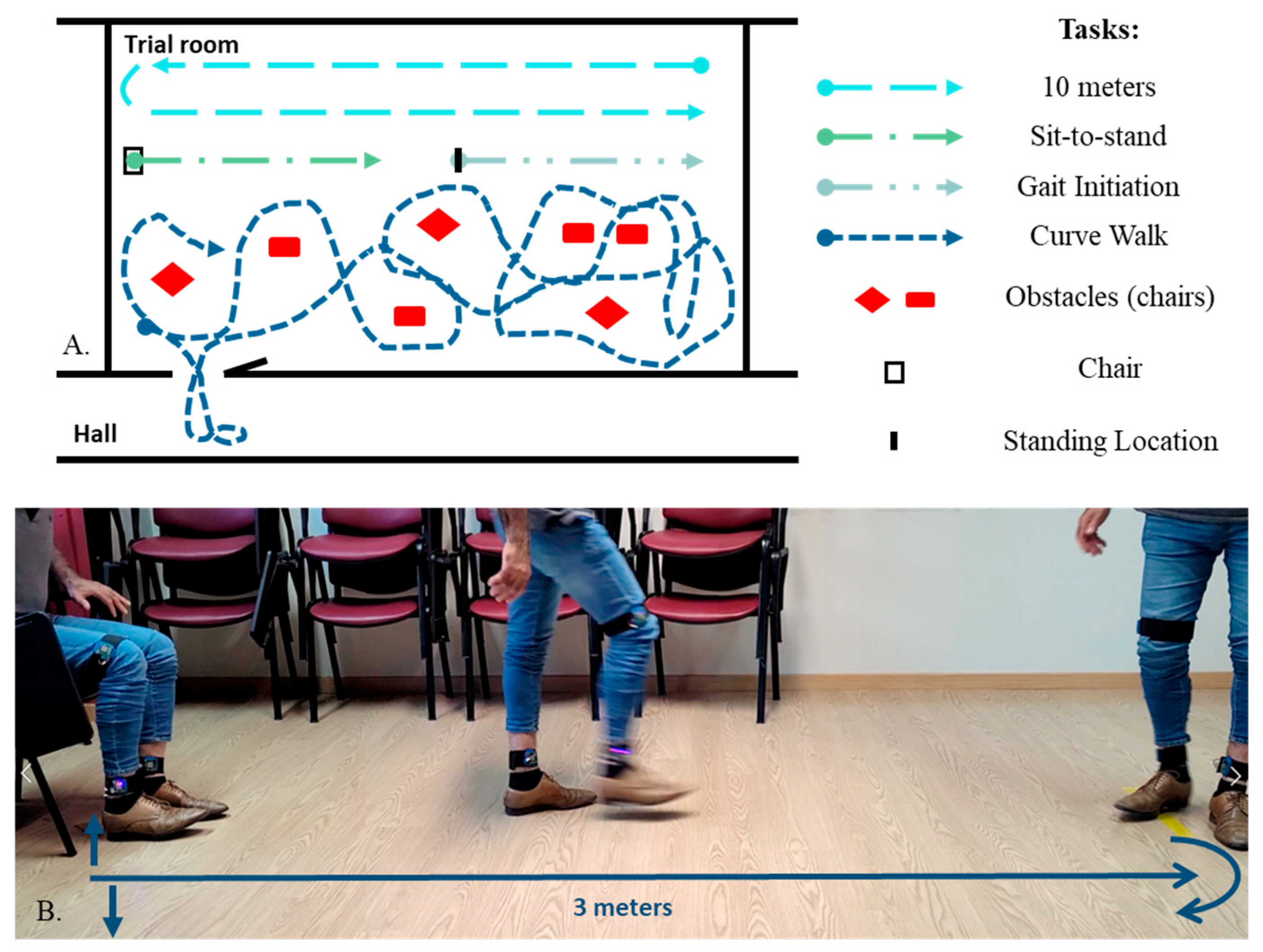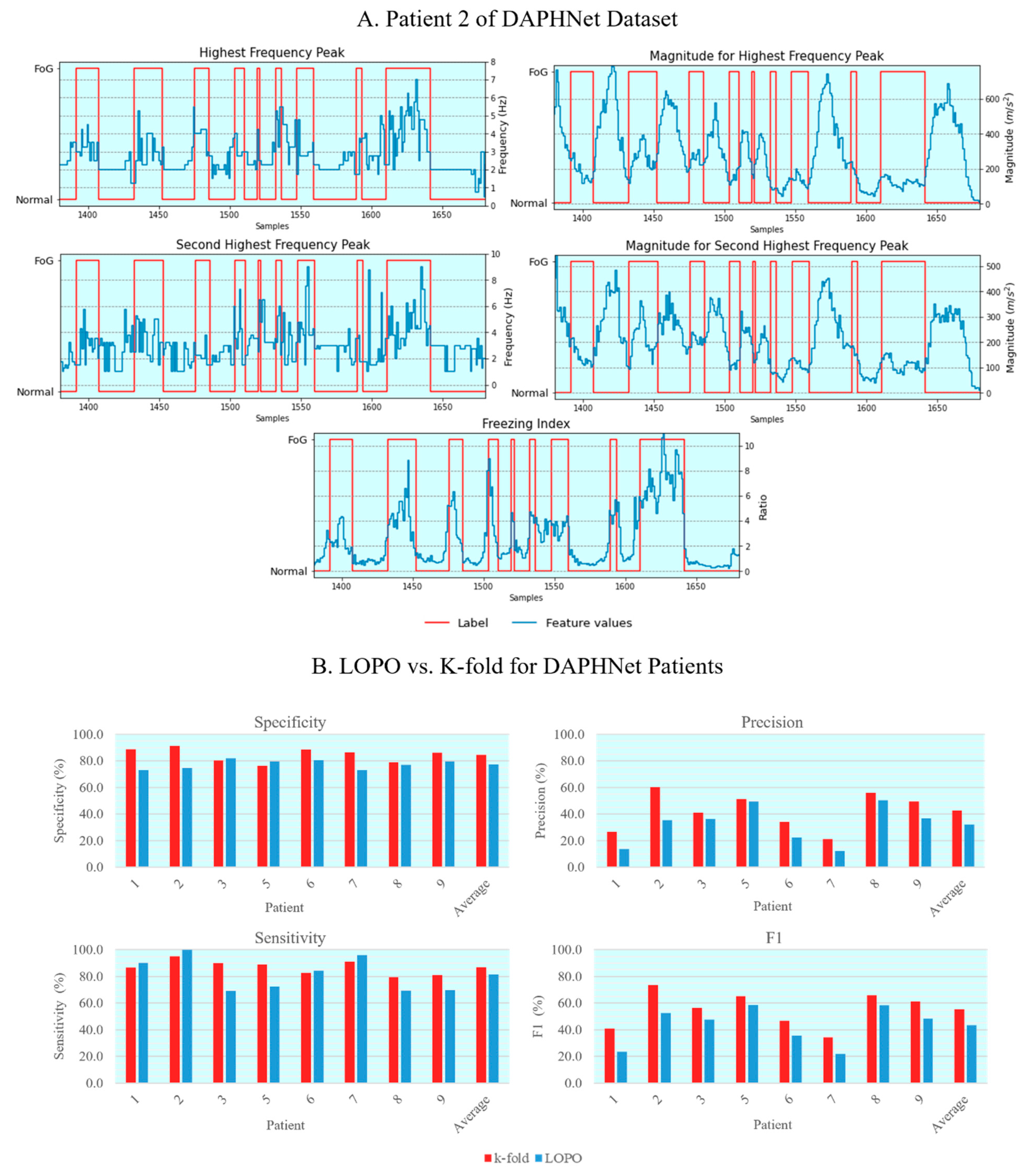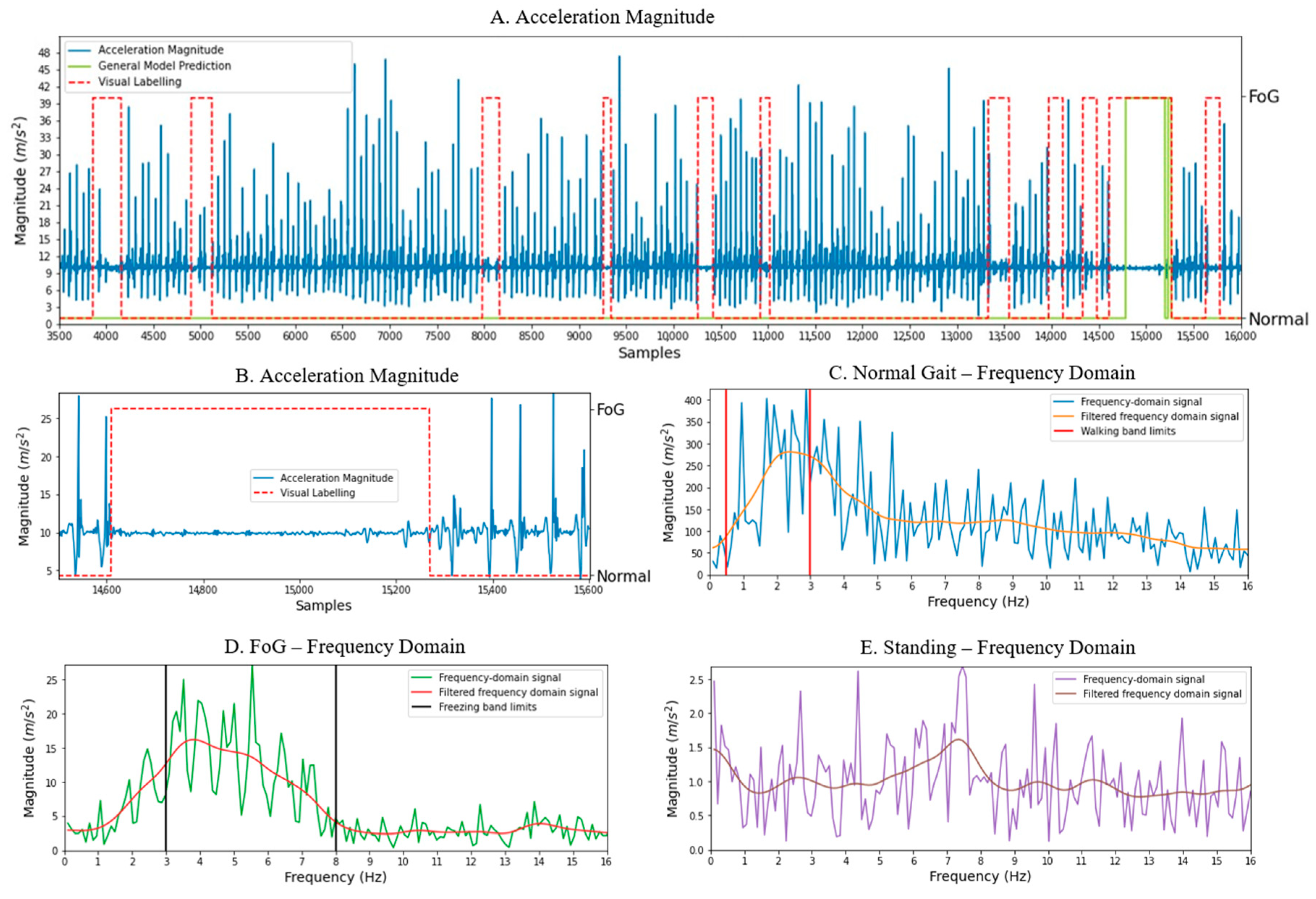ParCuR—A Novel AI-Enabled Gait Cueing Wearable for Patients with Parkinson’s Disease
Abstract
1. Introduction
2. Materials and Methods
2.1. System Architecture and Device Implementation
2.1.1. Hardware
2.1.2. Software
2.2. Algorithm Implementation
2.3. Experimental Setup
Experimental Protocol
3. Results
3.1. Detecting Freezing of Gait Episodes Using the DAPHNet Dataset
3.2. Testing the System on Human Subjects
4. Discussion
Supplementary Materials
Author Contributions
Funding
Institutional Review Board Statement
Informed Consent Statement
Data Availability Statement
Acknowledgments
Conflicts of Interest
Abbreviations
| FOG | Freezing of Gait |
| ParCuR | Parkinson Cueing and Rehabilitation |
| PwP | Patients with Parkinson |
| PD | Parkinson’s Disease |
| IMU | Inertial Measurement Unit |
| PCB | Printed Circuit Board |
| ML | Machine Learning |
| µC | Microcontroller |
| ADL | Activities of Daily Living |
| FI | Freezing Index |
| RMS | Root Mean Square |
| STD | Standard Deviation |
| ZCR | Zero Crossing Rate |
| MCR | Mean Crossing Rate |
| LOPO | Leave-One-Patient-Out |
| K-fold | K-Fold Cross-Validation |
| SVM | Support Vector Machines |
| CRS | Comfort Rating Scales |
| HFP | Highest Frequency Peak |
| SHFP | Second Highest Frequency Peak |
| MHFP | Magnitude of Highest Frequency Peak |
| MSHFP | Magnitude of Second Highest Frequency Peak |
References
- Caligiore, D.; Helmich, R.C.; Hallett, M.; Moustafa, A.A.; Timmermann, L.; Toni, I.; Baldassarre, G. Parkinson’s disease as a system-level disorder. NPJ Park. Dis. 2016, 2, 16025. [Google Scholar] [CrossRef]
- Poewe, W.; Seppi, K.; Tanner, C.M.; Halliday, G.M.; Brundin, P.; Volkmann, J.; Schrag, A.-E.; Lang, A.E. Parkinson disease. Nat. Rev. Dis. Primers 2017, 3, 17013. [Google Scholar] [CrossRef]
- Zhang, W.S.; Gao, C.; Tan, Y.Y.; Chen, S.D. Prevalence of freezing of gait in Parkinson’s disease: A systematic review and meta-analysis. J. Neurol. 2021, 268, 4138–4150. [Google Scholar] [CrossRef]
- Schaafsma, J.D.; Balash, Y.; Gurevich, T.; Bartels, A.L.; Hausdorff, J.M.; Giladi, N. Characterization of freezing of gait subtypes and the response of each to levodopa in Parkinson’s disease. Eur. J. Neurol. 2003, 10, 391–398. [Google Scholar] [CrossRef]
- Magrinelli, F.; Picelli, A.; Tocco, P.; Federico, A.; Roncari, L.; Smania, N.; Zanette, G.; Tamburin, S. Pathophysiology of Motor Dysfunction in Parkinson’s Disease as the Rationale for Drug Treatment and Rehabilitation. Park. Dis. 2016, 2016, 9832839. [Google Scholar] [CrossRef]
- Nonnekes, J.; Růžička, E.; Nieuwboer, A.; Hallett, M.; Fasano, A.; Bloem, B.R. Compensation strategies for gait impairments in parkinson disease: A review. JAMA Neurol. 2019, 76, 718–725. [Google Scholar] [CrossRef] [PubMed]
- Sweeney, D.; Quinlan, L.R.; Browne, P.; Richardson, M.; Meskell, P.; Ólaighin, G. A technological review of wearable cueing devices addressing freezing of gait in Parkinson’s disease. Sensors 2019, 19, 1277. [Google Scholar] [CrossRef] [PubMed]
- Delgado-Alvarado, M.; Marano, M.; Santurtún, A.; Urtiaga-Gallano, A.; Tordesillas-Gutierrez, D.; Infante, J. Nonpharmacological, nonsurgical treatments for freezing of gait in Parkinson’s disease: A systematic review. Mov. Disord. 2020, 35, 204–214. [Google Scholar] [CrossRef]
- Muralidharan, V.; Balasubramani, P.P.; Chakravarthy, V.S.; Gilat, M.; Lewis, S.J.G.; Moustafa, A.A. A neurocomputational model of the effect of cognitive load on freezing of gait in parkinson’s disease. Front. Hum. Neurosci. 2017, 10, 649. [Google Scholar] [CrossRef] [PubMed]
- Ni, M.; Hazzard, J.B.; Signorile, J.F.; Luca, C. Exercise Guidelines for Gait Function in Parkinson’s Disease: A Systematic Review and Meta-analysis. Neurorehabilit. Neural Repair 2018, 32, 872–886. [Google Scholar] [CrossRef]
- Janssen, S.; de Ruyter van Steveninck, J.; Salim, H.S.; Cockx, H.M.; Bloem, B.R.; Heida, T.; van Wezel, R.J.A. The Effects of Augmented Reality Visual Cues on Turning in Place in Parkinson’s Disease Patients with Freezing of Gait. Front. Neurol. 2020, 11, 185. [Google Scholar] [CrossRef]
- Cao, S.S.; Yuan, X.Z.; Wang, S.H.; Taximaimaiti, R.; Wang, X.P. Transverse Strips Instead of Wearable Laser Lights Alleviate the Sequence Effect Toward a Destination in Parkinson’s Disease Patients with Freezing of Gait. Front. Neurol. 2020, 11, 838. [Google Scholar] [CrossRef]
- Reis Carneiro, M.; Majidi, C.; Tavakoli, M. Multi-Electrode Printed Bioelectronic Patches for Long-Term Electrophysiological Monitoring. Adv. Funct. Mater. 2022, 32, 2205956. [Google Scholar] [CrossRef]
- Reis Carneiro, M.; de Almeida, A.T.; Tavakoli, M.; Majidi, C. Recyclable Thin-Film Soft Electronics for Smart Packaging and E-Skins. Adv. Sci. 2023, 10, 2301673. [Google Scholar] [CrossRef]
- Carneiro, M.R.; De Almeida, A.T.; Tavakoli, M. Wearable and Comfortable e-Textile Headband for Long-Term Acquisition of Forehead EEG Signals. IEEE Sens. J. 2020, 20, 15107–15116. [Google Scholar] [CrossRef]
- Carneiro, M.R.; Tavakoli, M. Wearable Pressure Mapping through Piezoresistive C-PU Foam and Tailor-Made Stretchable e-Textile. IEEE Sens. J. 2021, 21, 27374–27384. [Google Scholar] [CrossRef]
- Dvorani, A.; Waldheim, V.; Jochner, M.C.E.; Salchow-Hömmen, C.; Meyer-Ohle, J.; Kühn, A.A.; Wenger, N.; Schauer, T. Real-Time Detection of Freezing Motions in Parkinson’s Patients for Adaptive Gait Phase Synchronous Cueing. Front. Neurol. 2021, 12, 720516. [Google Scholar] [CrossRef] [PubMed]
- Naghavi, N.; Wade, E. Prediction of freezing of gait in Parkinson’s disease using statistical inference and lower-limb acceleration data. IEEE Trans. Neural Syst. Rehabil. Eng. 2019, 27, 947–955. [Google Scholar] [CrossRef] [PubMed]
- van Cranenburgh, S.; Wang, S.; Vij, A.; Pereira, F.; Walker, J. Choice modelling in the age of machine learning—Discussion paper. J. Choice Model. 2022, 42, 100340. [Google Scholar] [CrossRef]
- McGill, A.; Houston, S.; Lee, R.Y.W. Dance for Parkinson’s: A new framework for research on its physical, mental, emotional, and social benefits. Complement. Ther. Med. 2014, 22, 426–432. [Google Scholar] [CrossRef]
- Avanzino, L.; Lagravinese, G.; Abbruzzese, G.; Pelosin, E. Relationships between gait and emotion in Parkinson’s disease: A narrative review. Gait Posture 2018, 65, 57–64. [Google Scholar] [CrossRef]
- Evers, L.J.W.; Peeters, J.M.; Bloem, B.R.; Meinders, M.J. Need for personalized monitoring of Parkinson’s disease: The perspectives of patients and specialized healthcare providers. Front. Neurol. 2023, 14, 1150634. [Google Scholar] [CrossRef] [PubMed]
- Antonini, A.; Reichmann, H.; Gentile, G.; Garon, M.; Tedesco, C.; Frank, A.; Falkenburger, B.; Konitsiotis, S.; Tsamis, K.; Rigas, G.; et al. Toward objective monitoring of Parkinson’s disease motor symptoms using a wearable device: Wearability and performance evaluation of PDMonitor®. Front. Neurol. 2023, 14, 1080752. [Google Scholar] [CrossRef] [PubMed]
- Klingner, C.M.; Nenadic, I.; Hasler, C.; Brodoehl, S.; Witte, O.W. Habituation within the somatosensory processing hierarchy. Behav. Brain Res. 2011, 225, 432–436. [Google Scholar] [CrossRef]
- Zhang, W.; Han, Y.; Shi, Y.; Yan, S.; Song, W.; Cui, G.; Xiang, J. Effects of wearable visual cueing on gait pattern and stability in patients with Parkinson’s disease. Front. Neurol. 2023, 14, 1077871. [Google Scholar] [CrossRef]
- Young, W.R.; Shreve, L.; Quinn, E.J.; Craig, C.; Bronte-Stewart, H. Auditory cueing in Parkinson’s patients with freezing of gait. What matters most: Action-relevance or cue-continuity? Neuropsychologia 2016, 87, 54–62. [Google Scholar] [CrossRef]
- Klaver, E.C.; van Vugt, J.P.P.; Bloem, B.R.; van Wezel, R.J.A.; Nonnekes, J.; Tjepkema-Cloostermans, M.C. Good vibrations: Tactile cueing for freezing of gait in Parkinson’s disease. J. Neurol. 2023, 270, 3424–3432. [Google Scholar] [CrossRef]
- Bächlin, M.; Plotnik, M.; Roggen, D.; Maidan, I.; Hausdorff, J.M.; Giladi, N.; Troster, G. Wearable assistant for Parkinsons disease patients with the freezing of gait symptom. IEEE Trans. Inf. Technol. Biomed. 2010, 14, 436–446. [Google Scholar] [CrossRef]
- Moore, S.T.; MacDougall, H.G.; Ondo, W.G. Ambulatory monitoring of freezing of gait in Parkinson’s disease. J. Neurosci. Methods 2008, 167, 340–348. [Google Scholar] [CrossRef] [PubMed]
- Moore, S.T.; Yungher, D.A.; Morris, T.R.; Dilda, V.; MacDougall, H.G.; Shine, J.M.; Naismith, S.L.; Lewis, S.J. Autonomous identification of freezing of gait in Parkinson’s disease from lower-body segmental accelerometry. J. Neuroeng. Rehabil. 2013, 10, 19. [Google Scholar] [CrossRef]
- Rodríguez-Martín, D.; Samà, A.; Pérez-López, C.; Català, A.; Arostegui, J.M.M.; Cabestany, J.; Bayés, À.; Alcaine, S.; Mestre, B.; Prats, A.; et al. Home detection of freezing of gait using Support Vector Machines through a single waist-worn triaxial accelerometer. PLoS ONE 2017, 12, e0171764. [Google Scholar] [CrossRef] [PubMed]
- Mazilu, S.; Calatroni, A.; Gazit, E.; Roggen, D.; Hausdorff, J.M.; Tröster, G. Feature learning for detection and prediction of freezing of gait in Parkinson’s disease. In Machine Learning and Data Mining in Pattern Recognition, Proceedings of the 9th International Conference, MLDM 2013, New York, NY, USA, 19–25 July 2013; Lecture Notes in Computer Science (Including Subseries Lecture Notes in Artificial Intelligence and Lecture Notes in Bioinformatics); Springer: Berlin/Heidelberg, Germany, 2013; Volume 7988. [Google Scholar]
- Bächlin, M.; Roggen, D.; Plotnik, M.; Hausdorff, J.M.; Giladi, N.; Tröster, G. Online detection of freezing of gait in Parkinson’s disease patients: A performance characterization. In Proceedings of the BODYNETS 2009—4th International ICST Conference on Body Area Networks, Los Angeles, CA, USA, 1–3 April 2009. [Google Scholar]
- Knight, J.F.; Baber, C.; Schwirtz, A.; Bristow, H.W. The comfort assessment of wearable computers. In Proceedings of the International Symposium on Wearable Computers, ISWC 2002, Seattle, WA, USA, 7–10 October 2002. [Google Scholar]
- Noce Kirkwood, R.; de Souza Moreira, B.; Mingoti, S.A.; Faria, B.F.; Sampaio, R.F.; Alves Resende, R. The slowing down phenomenon: What is the age of major gait velocity decline? Maturitas 2018, 115, 31–36. [Google Scholar] [CrossRef] [PubMed]
- O’Day, J.; Lee, M.; Seagers, K.; Hoffman, S.; Jih-Schiff, A.; Kidzi’nski, L.; Delp, S.; Bronte-Stewart, H. Assessing inertial measurement unit locations for freezing of gait detection and patient preference. J. Neuroeng. Rehabil. 2022, 19, 20. [Google Scholar] [CrossRef] [PubMed]





| Author | Year | Patients | Sensors | Location | Methods | Contributions | Sliding Window | Sampling Freq. | Delay | |
|---|---|---|---|---|---|---|---|---|---|---|
| Moore et al. [29] | 2008 | 11 | 1 IMU | Left Ankle | Threshold-based (FI) | Introduction of FI Generic threshold detected 78.3% Patient adapted threshold detected 89.1% | 6 s | 100 Hz | (Offline analysis) | |
| Bächlin et al. [28] | 2010 | 10 | 1 IMU | Left Ankle | Threshold-based (FI&PI) | Introduction of PI Online detection with generic thresholds Sensitivity: 73.1%; Specificity: 81.6% | 4 s Step: 0.5 s | 64 Hz | Max. 2 s | |
| Moore et al. [30] | 2013 | 25 | 7 IMU | Lower back, ankles, feet and knees | Threshold-based FI | Evaluation of different sensor locations, windows size and threshold values | Sensitivity: 84.3% Specificity: 78.4% | 7.5 s | 50 Hz | (Offline analysis) |
| 1 IMU | Left or Right Ankle | Sensitivity: 86.2% Specificity: 66.7% | ||||||||
| Mazilu et al. [32] | 2014 | 5 | 2 IMU | Ankles | Decision tree classifier | Detected: 99 of 102 real episodes and 27 false alarms Sensitivity: 97% | 2 s Step: 0.25 s | 32 Hz | Max. 0.5 s | |
| Rodríguez-Martín et al. [31] | 2017 | 21 | 1 IMU | Waist | SVM | Generic model—not adapted to any patient Sensitivity: 74.7%; Specificity: 79.0% | 3.2 s Step: 1.6 s | 40 Hz | (Offline analysis) | |
| Personalised model–trained per patient Sensitivity: 88.1%; Specificity: 80.1% | ||||||||||
| O’Day et al. [36] | 2022 | 7 | 1 IMU | Ankle | CNN | AUROC *: 0.80 Precision: 61% | 2 s | 64 Hz | (Offline analysis) | |
| This study | - | 10 | 1 IMU | Ankle | SVM | 14 frequency-based features Sensitivity: 94.9%; Specificity: 91.3% | 4 s Step: 0.5 s | 64 Hz | 0.7 s | |
Disclaimer/Publisher’s Note: The statements, opinions and data contained in all publications are solely those of the individual author(s) and contributor(s) and not of MDPI and/or the editor(s). MDPI and/or the editor(s) disclaim responsibility for any injury to people or property resulting from any ideas, methods, instructions or products referred to in the content. |
© 2025 by the authors. Licensee MDPI, Basel, Switzerland. This article is an open access article distributed under the terms and conditions of the Creative Commons Attribution (CC BY) license (https://creativecommons.org/licenses/by/4.0/).
Share and Cite
Lopes, T.; Reis Carneiro, M.; Morgadinho, A.; Reis Carneiro, D.; Tavakoli, M. ParCuR—A Novel AI-Enabled Gait Cueing Wearable for Patients with Parkinson’s Disease. Sensors 2025, 25, 7077. https://doi.org/10.3390/s25227077
Lopes T, Reis Carneiro M, Morgadinho A, Reis Carneiro D, Tavakoli M. ParCuR—A Novel AI-Enabled Gait Cueing Wearable for Patients with Parkinson’s Disease. Sensors. 2025; 25(22):7077. https://doi.org/10.3390/s25227077
Chicago/Turabian StyleLopes, Telmo, Manuel Reis Carneiro, Ana Morgadinho, Diogo Reis Carneiro, and Mahmoud Tavakoli. 2025. "ParCuR—A Novel AI-Enabled Gait Cueing Wearable for Patients with Parkinson’s Disease" Sensors 25, no. 22: 7077. https://doi.org/10.3390/s25227077
APA StyleLopes, T., Reis Carneiro, M., Morgadinho, A., Reis Carneiro, D., & Tavakoli, M. (2025). ParCuR—A Novel AI-Enabled Gait Cueing Wearable for Patients with Parkinson’s Disease. Sensors, 25(22), 7077. https://doi.org/10.3390/s25227077







